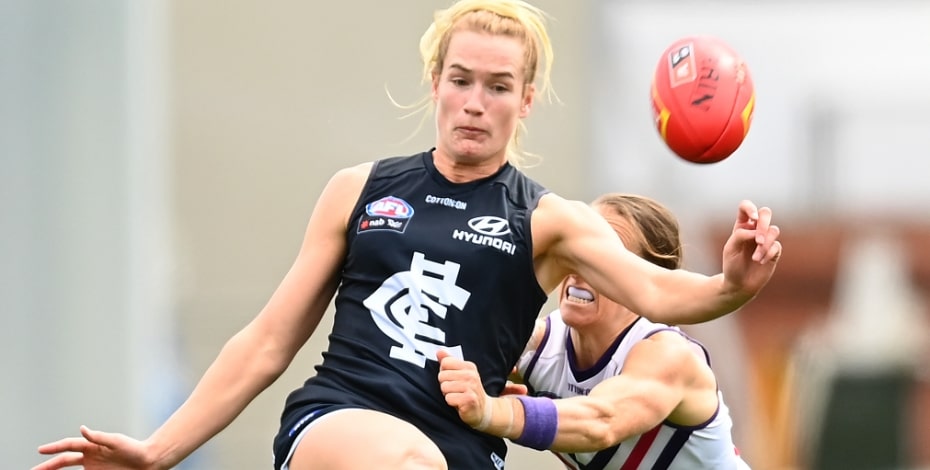
You get your kicks and you wear some bumps

With the sixth season of the Australian Football League Women’s competition scheduled to kick off early next year, Matt Pallozzi shares some of the ups and downs of working at an elite level.
I’ve been very fortunate in my physiotherapy career.
I’ve had some wonderful opportunities presented to me and I’ve always tried to accept them with open arms.
In my undergraduate days, my university peers, knowing that I played sport, would say that they could see me working as a sports physiotherapist.
In truth, I didn’t think it would happen after I started my career as a hospital-based physiotherapist.
However, after opportunity came knocking, I was appointed Hawthorn Football Club’s inaugural head physiotherapist in the Victorian Women’s Football League competition.
Fast-forward five years and I am about to begin my first season as head physiotherapist in the Collingwood Football Club’s Australian Football League Women’s (AFLW) program after fulfilling the same role in the preceding two seasons for the Carlton Football Club AFLW team.
For sports physiotherapists, it’s great to work at the elite level.
We have access to athletes three or four times per week for treatment, we are able to progress their rehab and, importantly, we have the chance to get to know them as people and to find out what makes them tick.
Having such a close working relationship and being able to drill down into each player’s psyche, motivation and drive for constant improvement and performance makes them ideal clients to work with.
At AFLW level, we have access to some of the most amazing equipment and state-of-the-art facilities available, ensuring that every player has the necessary tools at their disposal to become elite.
Networking opportunities provide players with the best medical and high-performance staff in the country.
World-leading surgeons, sports physicians and strength and conditioning coaches are a phone call or two away from being at the players’ disposal and are available to complement the excellent in-house medical teams.
This means that we can follow best practice and ensure the best possible outcomes for our athletes.
In a community setting, it isn’t practical or financially possible to see a client three or four times per week as clinically indicated.
These factors count and I point to them whenever I am asked how the players can perform week after week in such a physical and brutal game.
While the chance to build wonderful relationships with players and staff, to share wins with the players and to play a small part in some of their achievements give me a great sense of accomplishment, it isn’t all fun and games because working in elite sport does have its challenges.

In addition to his own practice, physiotherapist Matt Pallozzi enjoys his role working with elite-level AFLW players.
The players at AFLW level are semi-professional, which means that although they are paid, the remuneration does not equal the time dedicated to the role.
This applies to staff as well.
Almost everyone at an AFLW club has a full-time job or study commitment, which means late nights and weekends.
There is no such thing as penalty rates in professional sport.
When a player calls at 7 am or 11.30 pm, I answer my phone because that’s just the nature of the beast.
Another consideration is travel.
It’s great for Frequent Flyer points, but, again, it means weekends and late nights.
Often we would check into the team hotel fresh off the bus and I would roll out the portable treatment table to complete some last-minute preparation with a player well into the wee hours of the morning, just to make sure the player felt ready leading into a game.
I hope that in the latest post-lockdown world we will be fortunate enough to be able to travel again across this great nation and take the game to some remote parts of the land.
By far the most confronting part of being a physiotherapist in professional sport is having the hard and often brutally honest conversations about the injuries or illnesses that result in players missing games—whether it be one or two weeks or, in the most difficult circumstances, a whole season or longer.
As it stands, the upcoming AFLW season will be played over 10 weeks only, with three weeks of finals.
The men’s AFL season comprises 22 games plus finals.
A single game in the AFLW therefore carries much greater weight, of which the AFLW players are acutely aware.
I’ve laughed with them a lot in my time in sport, but I’ve definitely cried for them too.
I’ve maintained a brave face when telling a player that they’ve torn an anterior cruciate ligament and will therefore miss the next 12 months, only to break down in tears myself a short while later.
Delivering that news to a player is truly heartbreaking at times.
Footy can be a cruel game.
But I love the players and I love the game; that’s why I do what I do, despite the negative aspects of the role.
I’ve faced some incredible challenges as a physiotherapist in elite-level sport but I wouldn’t change it for the world—except for those nasty injuries.
>> Matt Pallozzi, APAM, is the head physiotherapist for the Collingwood Football Club AFLW team. Matt is also the director and senior physiotherapist at Instinct Health in Melbourne, which he founded in 2017 after working across a number of hospital settings and in neurological rehabilitation. The sixth AFLW season is due to commence in early January 2022.
© Copyright 2024 by Australian Physiotherapy Association. All rights reserved.





